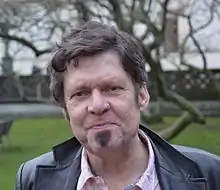Lars Samuelson (physicist)
Lars Ivar Samuelson (born 20 December 1948), is a Swedish physicist and professor in nanotechnology and Semiconductor physics[1] at Lund University.
Lars Samuelson | |
|---|---|
 Samuelson in 2011 | |
| Born | December 20, 1948 Malmö, Sweden |
| Nationality | Swedish |
| Alma mater | Chalmers University of Technology |
| Known for | Nanowires |
| Scientific career | |
| Fields | Physics |
| Institutions | University of Lund |
Biography
In 1977 Lars Samuelson was awarded his PHD at Lund University. Afterwards he was a postdoc at the IBM Research facility in San Jose, California between 1978-1979 and a professor of semiconductor physics at Chalmers University of Technology in 1986. In 1988 he became a professor of semiconductor electronics at the Department of Physics at Lund University, and in the same year was involved in the creation of Scandinavia's first research center, Nanometer Consortium.[2] In 2000 he began to focus the Nanometer Consortium's research on Nanowires. In 2002, he became one of the first in the world to show how to combine substances with different electrical properties in a nanowire.[3] Based on the research of nanowires, Samuelson founded three companies: Qunano, Sol Voltaics and Glo.[4] Lars Samuelson became a member of the Royal Swedish Academy of Sciences in 2006[5] and the Engineering Academy of 2007. In 2008 he was appointed Einstein Professor of the Chinese Academy of Sciences. He is ranked third on the journal Nano Letters list of the most productive researchers in nanosciences in the years 2001-2009.[6]
References
- "Lars Samuelson". Retrieved June 25, 2017.
- Wickberg, Jenny. "Han skapar lekplatser för elektroner". SvD.se (in Swedish). Retrieved 2017-05-27.
- Radio, Sveriges. "Nanotrådar leder mot energisnål teknik - Vetandets värld". sverigesradio.se (in Swedish). Retrieved 2017-05-27.
- "Första nanobolaget nära genombrottet". Sydsvenskan (in Swedish). Retrieved 2017-05-27.
- "Kungl. Vetenskapsakademien". kva.se. Retrieved 2017-05-27.
- "Most Prolific Authors". pubs.acs.org. Retrieved 2017-05-27.